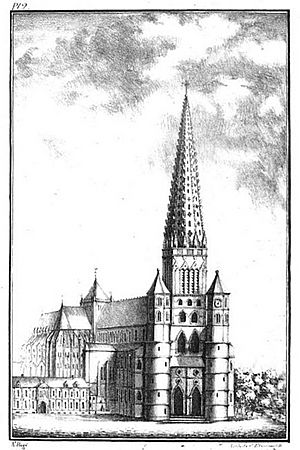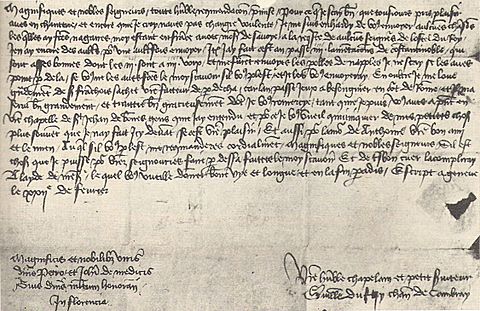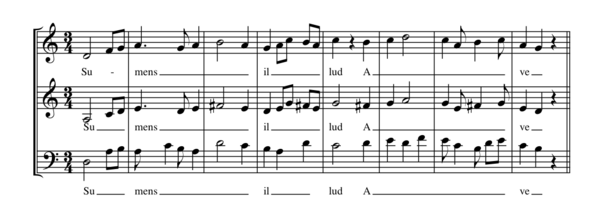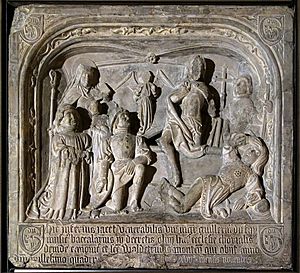Guillaume Du Fay facts for kids
Guillaume Du Fay (/djuːˈfaɪ/ DYOO-feye) was a famous French composer and music thinker from the early Renaissance period. He was born around August 5, 1397, and passed away on November 27, 1474.
Many people thought Du Fay was the most important European composer of his time. His music was played and copied everywhere. He was good friends with composers from the Burgundian School, especially Gilles Binchois.
Du Fay's life is well-known, even though his birth and family background are a bit of a mystery. He grew up in Cambrai, France, and learned music at Old Cambrai Cathedral. His teachers included Nicolas Grenon and Richard Loqueville.
For about ten years, Du Fay worked in different places across Europe. He was a church official in Cambrai, then worked for noble families in Italy, like the Malatesta family in Rimini and Pesaro. He also worked for Louis Aleman in Bologna, where he became a priest.
As his fame grew, Du Fay moved to Rome in 1428. He became a musician in the important papal choir, working for Pope Martin V and later Pope Eugene IV. During this time, he wrote famous motets like Balsamus et munda cera. In the 1430s, Rome faced money and political problems, so Du Fay left the choir for a while to work for Amadeus VIII, Duke of Savoy.
Du Fay returned to Italy in 1436. He wrote one of his most admired works, the motet Nuper Rosarum Flores. This piece celebrated the completion of Filippo Brunelleschi's famous dome for the Florence Cathedral. He later joined the papal court in Bologna and also worked with the House of Este family in Ferrara.
For the next eleven years, Du Fay was back in Cambrai, working for Philip the Good. He might have written some books about music theory during this time, but they are now lost. After short trips back to Savoy and Italy, Du Fay settled in Cambrai in 1458. His focus changed from songs and motets to writing large, connected pieces called cyclic masses. These masses were inspired by English music and used a main melody called a cantus firmus. Examples include the Missa Ave regina celorum and the Missa L'Homme armé.
In his final years in Cambrai, Du Fay wrote a Requiem Mass (which is now lost). He also met and influenced many important musicians of his time, such as Antoine Busnois, Loyset Compère, Johannes Tinctoris, and especially Johannes Ockeghem.
Du Fay is seen as one of the first European musicians who were mainly known as 'composers'. His travels across Western Europe helped him create a "cosmopolitan style" of music. He wrote many different kinds of pieces, covering almost every type of polyphonic music (music with multiple independent melodies) of his era. Like Binchois, Du Fay was greatly influenced by the English style called contenance angloise from John Dunstaple. He combined this with other styles, including techniques from younger composers like Ockeghem and Busnois.
Life Story of a Composer
Early Years and Education
We know a lot about Du Fay's life, more than almost any other composer from the 1400s. This is because the places he worked kept very good records. Also, many of his musical pieces tell us things about his life. The records from Old Cambrai Cathedral in France are especially helpful, as they were saved while many others were lost.
Today, people usually spell his last name as two words: 'Du Fay'. But before the late 1900s, 'Dufay' (one word) was more common. Old documents show that in the 1300s and 1400s, his family often spelled it 'Du Fayt'. Du Fay himself changed the spelling when he was working in Italy. In his early years in Cambrai, his first name was sometimes spelled Willaume or similar forms.
Du Fay was probably born in Beersel, near Brussels. His mother, Marie Du Fayt, moved with him to Cambrai when he was young. They stayed with a relative who was a church official at the cathedral there. Because of this connection, we know a lot about Du Fay's childhood.
The church leaders noticed his musical talent. They gave him excellent music training. He was a choirboy at the cathedral from 1409 to 1412. He even received his own copy of a special book called Doctrinale Puerorum in 1411, which was very unusual for someone so young. By 1414, he had already become a chaplain at a church near Cambrai. Later that year, he likely traveled to the Council of Constance and stayed there until 1418.
Working in Italy and Savoy
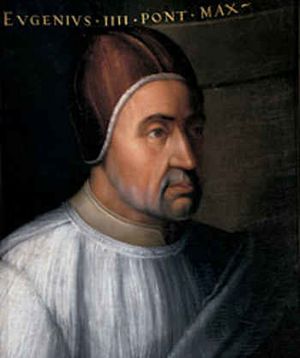
From 1418 to 1420, Du Fay worked as a subdeacon at Old Cambrai Cathedral. In 1420, he left Cambrai and went to Italy. He worked for the Malatesta family in Rimini and Pesaro. Some of his songs from this time have Italian words in them. He met other composers there, like Hugo and Arnold de Lantins.
In 1424, Du Fay returned to Cambrai because a relative his mother was staying with became ill and passed away. But by 1426, he was back in Italy. In Bologna, he started working for Louis Aleman, a church leader. While in Bologna, he became a deacon, and by 1428, he was ordained as a priest.
When Cardinal Aleman had to leave Bologna in 1428, Du Fay also left and went to Rome. He joined the Papal Choir, which was the most respected music group in Europe. He worked for Pope Martin V and then, after the Pope's death in 1431, for Pope Eugene IV. By this time, Du Fay was very famous and respected across Europe. He received many honors from churches in his home country.
In 1434, he became the choirmaster in Savoy, working for Duke Amédée VIII. He had left Rome because of money problems in the papal choir and the political unrest between the Pope and the Council of Basel. By 1435, he was back with the papal chapel, but this time in Florence. Pope Eugene had been forced to leave Rome in 1434.
In 1436, Du Fay wrote his famous motet Nuper rosarum flores. This piece was written for the dedication of Filippo Brunelleschi's amazing dome on the Florence Cathedral. The Pope was living in exile nearby at that time.
The papal court moved to Bologna in 1436. By 1437, Du Fay had a law degree from a university. He likely got this degree directly from the Pope, as there's no record of him studying law. In September 1436, Du Fay finally got a good position near his birthplace: a canonicate at Cambrai. He thought both his law degree and this church position were important enough to be mentioned on his tombstone.
During this time, Du Fay also started working with the House of Este family in Ferrara. They were very important supporters of music during the Renaissance. Du Fay had probably met them when he worked for the Malatesta family, as the two families were connected. He even wrote a song for Niccolò III d'Este, the Marquis of Ferrara. When Niccolò died in 1441, his successor continued to support Du Fay and helped share his music.
Back to Cambrai
The arguments between the Pope and the Council of Basel continued through the 1430s. Du Fay realized his own job might be at risk, especially after the Council removed Pope Eugene in 1439 and replaced him with Duke Amédée of Savoy (who became Pope Felix V). So, Du Fay returned to his homeland, arriving in Cambrai by December 1439. One of the first records of him in Cambrai is from December 27, 1440, when he received wine for a church feast.
Du Fay stayed in Cambrai throughout the 1440s. During this time, he also worked for the Duke of Burgundy. In Cambrai, he worked with Nicolas Grenon to update the cathedral's music collection. This included writing many new polyphonic pieces for church services. Besides his music, he also helped manage the cathedral. In 1444, his mother Marie passed away and was buried in the cathedral. In 1445, Du Fay moved into the house of the previous church official, which became his main home for the rest of his life. Some experts believe Du Fay might have written his books on music theory around this time, but they are now lost.
More Travels and Final Return
After the last "antipope" (Felix V) stepped down in 1449, the Church began to heal its divisions. Du Fay left Cambrai again and traveled south. He went to Turin in 1450, just before Duke Amédée died, but returned to Cambrai later that year. In 1452, he went back to Savoy. This time, he stayed away from Cambrai for six years. During these years, he tried to find a job or position that would let him stay in Italy.
Many of his compositions from this period still exist, including one of his four Lamentations about the Fall of Constantinople in 1453. His famous mass based on Se la face ay pale and a letter to Lorenzo de' Medici also come from this time. However, he couldn't find a good permanent job for his retirement, so he returned north in 1458. While in Savoy, he officially served as choirmaster for Louis, Duke of Savoy, but it was probably more of a ceremonial role.
When he returned to Cambrai for his final years, he was appointed a canon of the cathedral. He was now the most famous composer in Europe. He again became close with the court of Burgundy and continued to write music for them. He also had many visitors, including important composers like Antoine Busnois, Johannes Ockeghem, Johannes Tinctoris, and Loyset Compère. These musicians were very important in developing the polyphonic style of the next generation.
During this time, Du Fay likely wrote his mass based on L'homme armé. He might also have written the song Il sera par vous – L'homme armé, which uses the same main melody. This song might have been inspired by Philip the Good's call for a new crusade against the Turks, who had recently captured Constantinople. Around 1460, he also wrote a Requiem Mass, but it is now lost.
After being ill for several weeks, Du Fay passed away on November 27, 1474. He had asked for his motet Ave regina celorum to be sung for him as he died, but there wasn't enough time. Instead, his lost Requiem Mass was performed at his funeral. Du Fay was buried in the chapel of St. Étienne in the Cambrai Cathedral. His portrait was carved onto his tombstone. The cathedral was destroyed during the French Revolution, and the tombstone was lost. But it was found in 1859 (it was being used to cover a well!) and is now in the Palais des Beaux-Arts de Lille museum in Lille.
Du Fay's Music
Du Fay wrote music in most of the popular styles of his time. This included:
- Sacred music: masses, motets, Magnificats, hymns, and simple chant settings.
- Secular music: rondeaux, ballades, virelais, and other types of chansons (songs).
None of his surviving music was specifically for instruments. However, instruments were definitely used for some of his secular (non-religious) music, especially for the lower parts. All of his sacred music was meant for voices. Instruments might have been used to support the voices in performances of almost any of his works.
We have found seven complete Masses, 28 individual Mass movements, 15 chant settings for Mass, three Magnificats, 15 antiphon settings (six of them Marian antiphons), 27 hymns, 22 motets, and 87 chansons that are definitely by him. Among his masses, Missa se la face ay pale and Missa L'Homme armé are considered very important.
Chant Settings
Many of Du Fay's pieces were simple settings of chants. These were clearly made for church services, probably to replace plain chants with something more harmonized. He often used a technique called fauxbourdon. This style creates parallel harmonies, as you can see in his setting of the Marian antiphon Ave maris stella:
Du Fay might have been the first composer to use the term "fauxbourdon" for this simpler style. It was very popular in church music during the 1400s, especially in the Burgundian school.
Secular Music (Songs)
Most of Du Fay's secular songs follow popular forms like the rondeau, ballade, and virelai. These forms were common in European secular music in the 1300s and 1400s. He also wrote a few Italian ballate, most likely when he was in Italy. Like his motets, many of his songs were written for special events, which helps us figure out when they were composed and gives us clues about his life.
Most of his songs are for three voices. The highest voice usually carries the main melody, while the other two voices, which didn't have lyrics, were probably played by instruments. Sometimes Du Fay used four voices, but in some of these songs, the fourth voice was added later by another composer. He typically used the rondeau form for love songs. His later secular songs show the influence of composers like Busnois and Ockeghem. In these pieces, the rhythm and melody are less different between the voices, moving towards the smooth polyphony that became popular 50 years later.
A good example of his ballades is Resvellies vous et faites chiere lye. He wrote this in 1423 for the wedding of Carlo Malatesta and Vittoria di Lorenzo Colonna. The music for each verse follows an aabC pattern, where C is the repeated part. The music highlights parts of the lyrics that talk about the married couple.
Music Theory Writings
We know about two books on music theory that Du Fay supposedly wrote, but neither of them has survived. The first is mentioned by a music theorist named Gaffurius, who wrote notes about a "Musica" by Du Fay. However, these notes are very short and don't tell us much.
The second book was mentioned by a music expert in the 1800s, François-Joseph Fétis. He claimed to have seen a copy of a book from the 1500s that was said to be by Du Fay. It was called Tractatus de musica mensurata et de proportionibus (which means 'A Treatise on Measured Music and Proportions'). The last time it was recorded was when it was sold to a book dealer in London in 1824. We don't know anything else about it, so it's hard to be sure.
If Du Fay did write these books, he would be part of a group of "composer-theorists" who wrote about music, like Johannes Ciconia and Johannes Tinctoris. It's possible that these two mentioned works are actually the same book.
Portraits of Du Fay
Two pictures of Du Fay from his lifetime still exist. Experts say they are "simplified likenesses" but "clearly show the same person."
The older and more famous picture is a small painting from a book by the poet Martin le Franc, made before 1451. This painting shows Du Fay on the left with a small organ, and Binchois on the right holding a small harp. This painting is in the Bibliothèque nationale de France in Paris. The artist is unknown, but they likely knew Du Fay personally.
The other picture is a carving on Du Fay's funeral monument. He is shown kneeling in the bottom left corner. Behind him is Saint Waltrude of Mons. To his right, three soldiers and an angel are watching the resurrected Christ.
Du Fay's Lasting Impact
Before Du Fay's time, the idea of a 'composer'—someone whose main job was to write music—was not very common in Europe. Musicians who focused on writing music started to appear in the 1400s, and Du Fay was a great example of this.
Du Fay was one of the last composers to use older medieval music styles, like isorhythm (a repeating rhythmic pattern). But he was also one of the first to use the smoother harmonies, melodies, and phrases that became popular in the early Renaissance. His major works (masses, motets, and songs) are often similar to each other. He is famous for how perfectly he controlled the musical forms he used, and for his talent in creating memorable and singable melodies.
During the 1400s, everyone thought he was the greatest composer of his time. This opinion has largely stayed true even today.
The Dufay Collective, a group that plays early music using old instruments, is named after Du Fay.
See also
 In Spanish: Guillaume Dufay para niños
In Spanish: Guillaume Dufay para niños



